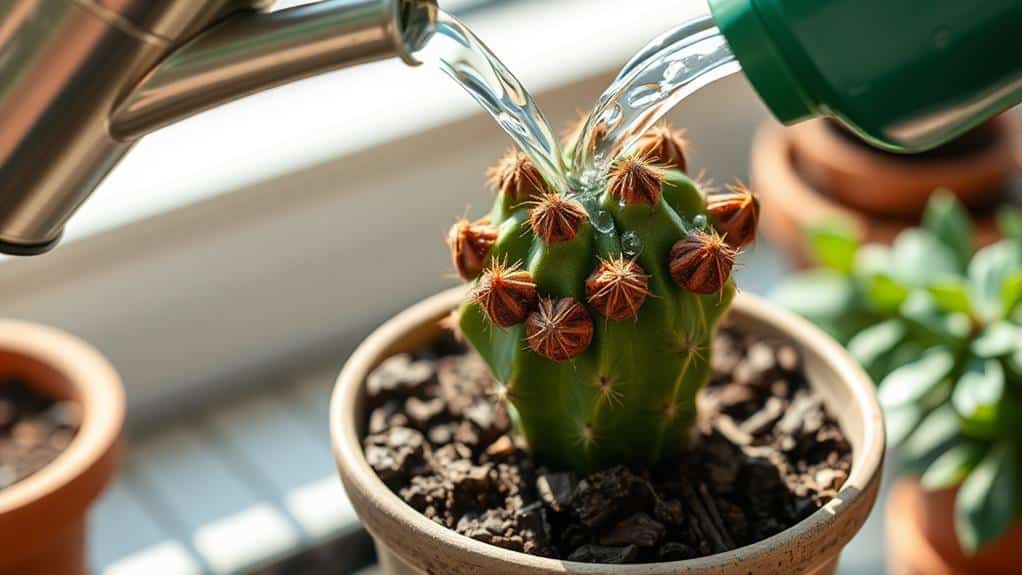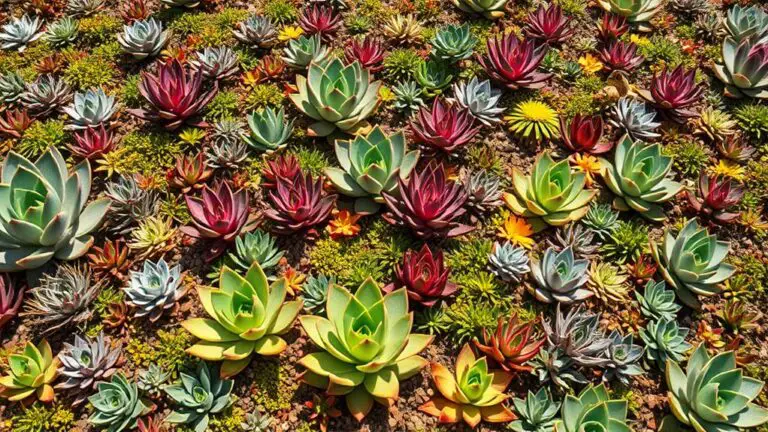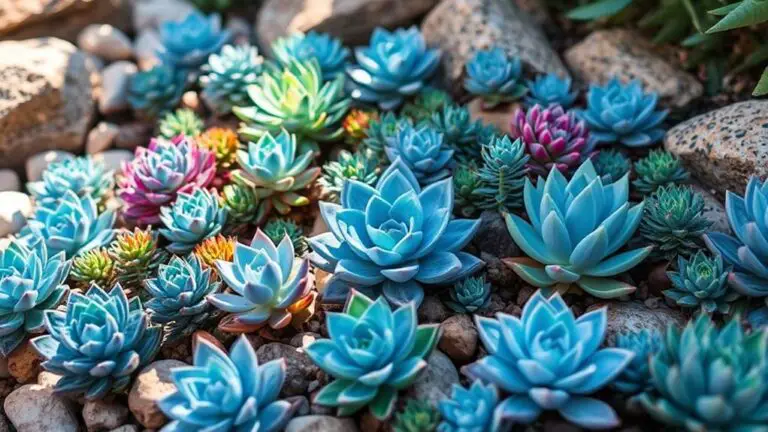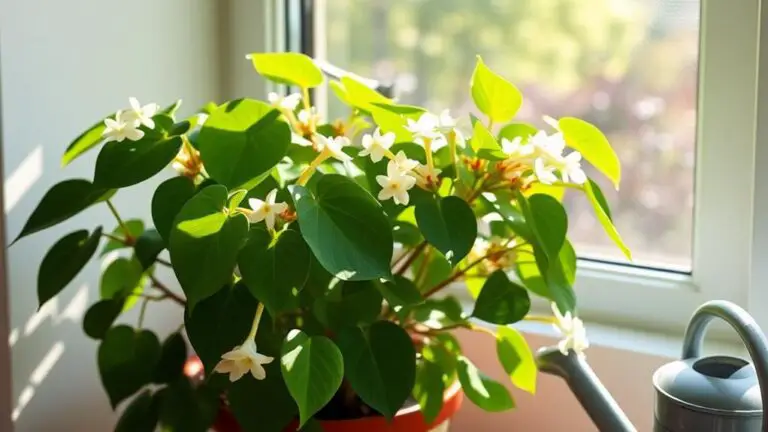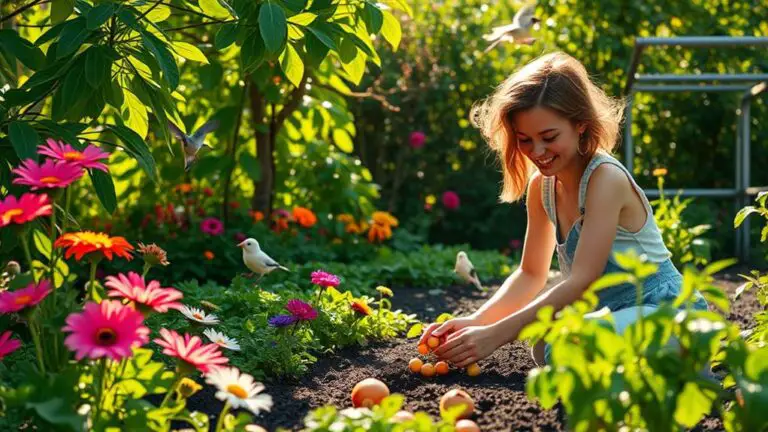7 Essential Steps to Save Your Dying Cactus
If your cactus looks like it's on its last legs, don't lose hope just yet. By following a few essential steps, you can often bring it back to life. Begin by identifying common issues such as root rot or pest infestations, as these are often the culprits behind a failing cactus. You'll then need to carefully cut away any rotting parts using sterilized tools. But that's just the beginning. Adjusting your watering patterns and optimizing sunlight exposure are equally vital steps that can make a world of difference. Curious about the rest? Let's explore how to turn things around.
Identify Common Issues
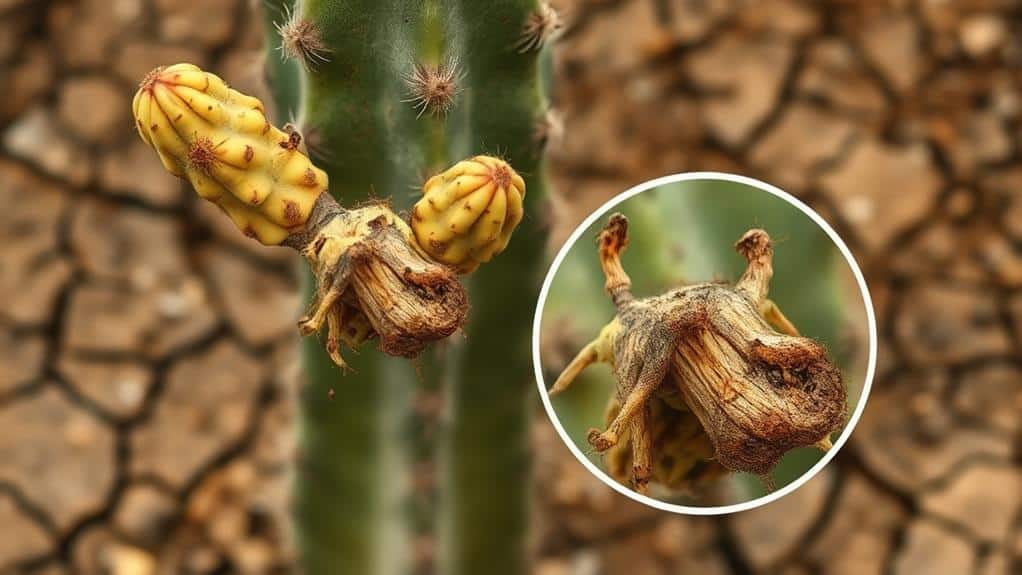
Spotting problems early is essential to saving your cactus. Check for root rot, which often results from excess water. If your cactus has brown spots or feels mushy, it might be overwatered. Healthy roots should be firm and white. Black or mushy roots need immediate attention. To avoid overwatering, verify the soil is dry before you water again.
Examine your cactus for discoloration. Yellowing or browning can indicate too much sunlight or dehydration. In contrast, wilting and wrinkling usually mean your plant isn't getting enough water. Look at the cactus segments closely. If they appear elongated and thin, the problem could be insufficient sunlight.
Keep an eye out for pests like spider mites, as they can cause yellowing and harm your cactus. Regularly inspect your cactus for tiny pests, especially on the undersides of the segments. If you spot any, act quickly to remove them.
Environmental factors play a big role too. Monitor temperature and humidity levels to verify they're suitable for your cactus.
Cut Away Rotting Parts
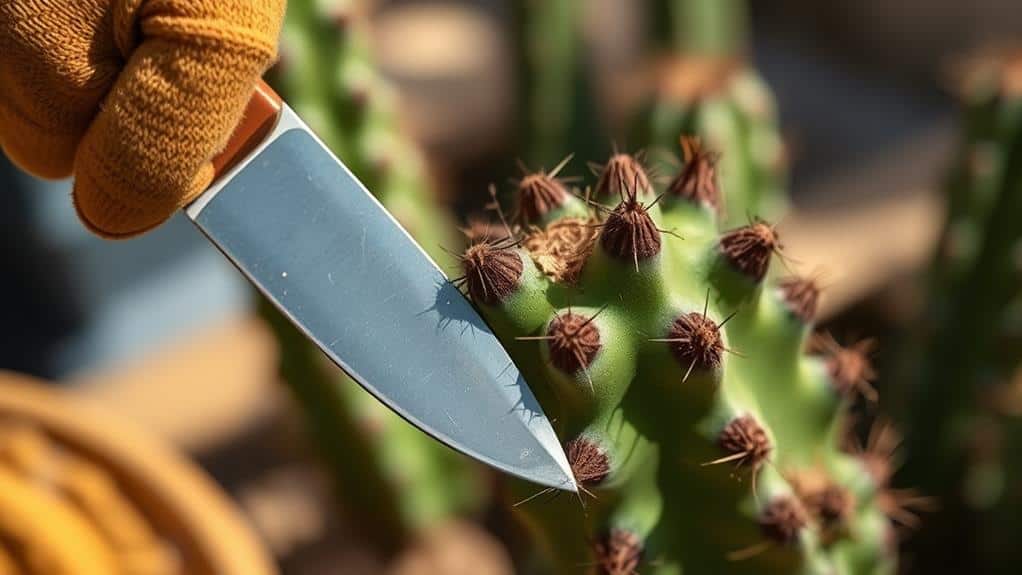
Recognizing signs of overwatering like black or brown spots means it's time to immediately cut away any rotting parts to prevent further decay.
Start by inspecting your cactus closely. Use sterilized tools to cut away the rotting parts carefully. This step is vital because using clean tools minimizes the risk of introducing more pathogens to your cactus.
After removing the rotting parts, it's a good idea to repot your cactus in well-draining soil. A mix of 1 part peat, 2 parts garden soil, and 2 parts coarse sand works well. This blend helps guarantee that water doesn't sit around the roots, which can lead to further overwatering issues.
Once you've cut away the rotting parts and repotted your cactus, allow the healthy portions to dry completely before watering again. This drying period is essential to prevent future rot.
Make it a habit to regularly inspect your cactus for any new signs of rot. By catching problems early, you can intervene before they become severe and maintain the overall health of your plant.
Taking these steps will go a long way in reviving your cactus and keeping it healthy in the future.
Adjust Watering Patterns
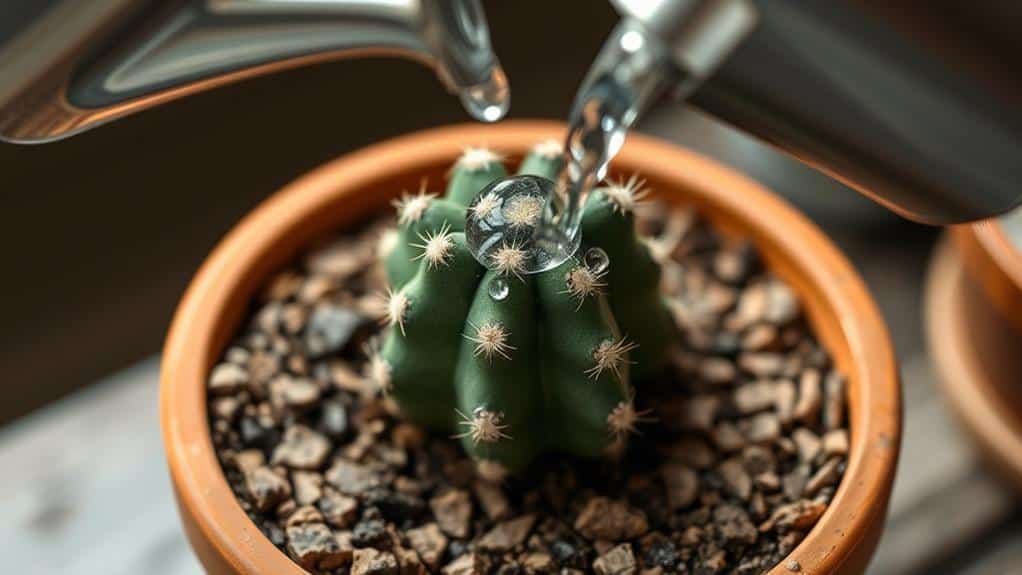
After cutting away the rotting parts and repotting your cactus, it's time to rethink how you water it. Overwatering is often the main cause of a dying cactus, so you need to adjust your watering patterns.
First, verify the soil is completely dry before you water your cactus again. Cacti prefer infrequent watering, usually every 2-4 weeks during the growing season.
Check the moisture level by sticking your finger into the soil or using a moisture meter. If the soil feels dry, it's time to water. However, if it's still damp, wait a few more days. Remember, soggy soil means you're overwatering, and you need to change your watering frequency.
Seasonal changes also matter. In the summer, cacti absorb water more quickly and might need slightly more frequent watering. In the winter, when they're dormant, drastically reduce watering.
Always use pots with drainage holes to prevent water from accumulating at the bottom. This helps avoid root rot and other issues.
Optimize Sunlight Exposure
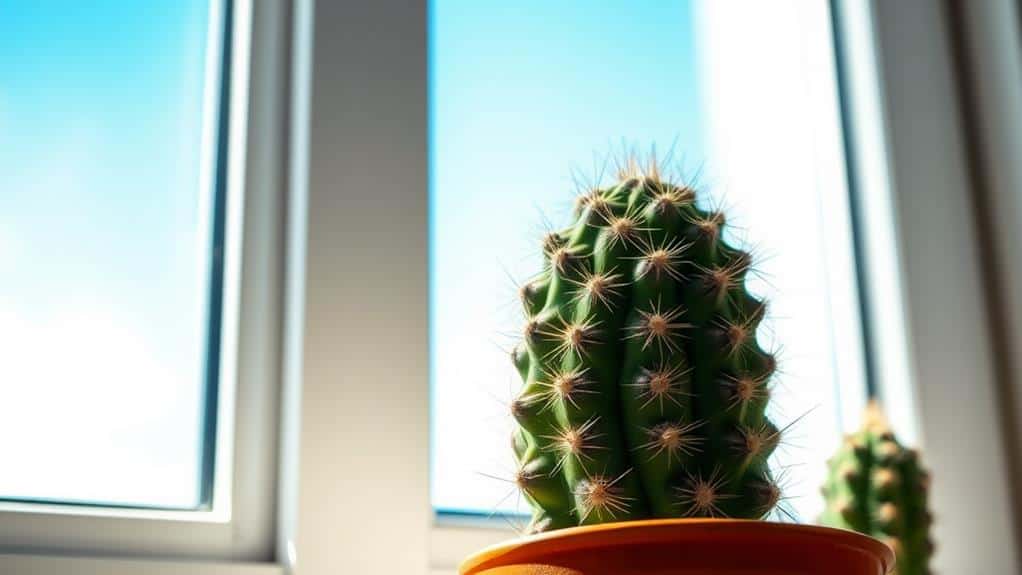
Proper sunlight exposure is essential for your cactus's health and growth. To save your dying cactus, you need to make sure it gets the right amount of light. Cacti thrive in bright, indirect sunlight, so placing your plant near a southern or western window is ideal. However, you must always check for signs of too much or too little sunlight.
Here's a simple guide to optimize sunlight exposure:
- Position: Place your cactus where it receives bright, indirect sunlight. Avoid harsh direct rays to prevent yellowing or burning.
- Monitor: Always check for signs of insufficient sunlight. Etiolation, or stretched and narrow growth, means your cactus needs more light.
- Clean: Regularly rinse your cactus with water to remove dust. This helps it absorb sunlight more effectively.
- Adjust: Move your cactus according to seasonal changes. In winter, consider using grow lights if natural sunlight is limited.
Control Pest Infestations
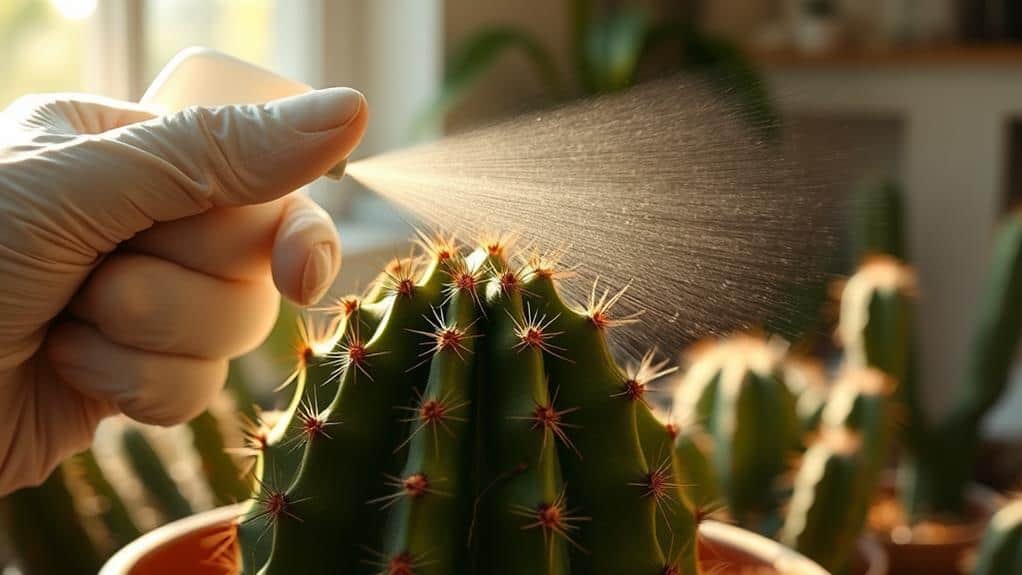
While guaranteeing your cactus gets the right amount of sunlight is essential, it's equally important to keep an eye out for pest infestations that could be harming your plant. Spider mites and mealybugs are common culprits that can cause significant damage, leading to yellowing and wilting if not addressed promptly.
Regularly inspect your cactus for signs of infestation, such as webbing from spider mites or cotton-like masses from mealybugs.
If you spot spider mites, rubbing alcohol is a simple yet effective solution. Apply it directly to the infested areas using a cotton swab or cloth. For mealybugs, insecticidal soap can help control their populations.
Make sure the product is safe for cacti and follow the application instructions closely to avoid any damage to your plant.
Maintaining a clean environment is also essential for a healthy cactus. Regularly wash dust and dirt off your cactus, as a clean plant is less susceptible to pest infestations.
Repot in Proper Soil

Repotting your cactus in the right soil mix is vital for its survival and growth.
You'll need to use a well-draining soil mix that prevents root rot and allows proper drainage. Here's a simple mix to follow: 2 parts garden soil, 2 parts coarse sand, and 1 part peat. This combination guarantees your cactus gets the best environment to thrive.
To start, follow these steps:
- Choose the Right Pot: Select a pot with drainage holes. This is important because it allows excess water to escape, preventing soggy conditions that can lead to root rot.
- Inspect the Roots: During repotting, carefully check the roots. Trim away any soft, black, or dead roots. This promotes healthy growth and helps your cactus recover.
- Repot in Growing Season: It's best to repot your cactus during the growing season, from March to September. This timing supports your cactus's recovery and adaptation to the new soil conditions.
- Water Thoroughly: After repotting, water your cactus thoroughly. Make sure the soil dries completely before the next watering to avoid reintroducing moisture-related issues.
Maintain Long-Term Health

After repotting your cactus in the right soil mix, it's important to focus on maintaining its long-term health.
Start by setting a consistent watering schedule. Make certain the soil is completely dry before the next watering. Adjust the frequency based on the seasons—more in summer, less in winter. Always use a well-draining soil mix to prevent root rot.
Next, fertilize your cactus during the growing season. Use a diluted, low-nitrogen fertilizer, like a 10-30-20 ratio. This supports ideal growth without overwhelming your cactus. Remember, less is more when it comes to feeding cacti.
Regularly inspect your cactus for pests and diseases. Early detection is key to preventing infestations. If you spot any issues, address them promptly to keep your plant healthy.
Every 2-3 years, or when it becomes root-bound, repot your cactus. This refreshes the soil and gives the roots more space to grow. Use the same well-draining soil mix you used before.
Lastly, monitor environmental conditions. Confirm your cactus gets plenty of light, warmth, and low humidity. These conditions are crucial for its health.
Frequently Asked Questions
How to Revive a Dying Cactus?
To revive a dying cactus, inspect it for distress signs like wilting or yellowing. Cut away rotting parts, adjust watering patterns, and guarantee it's in bright, indirect sunlight. Regularly monitor for pests and treat infestations promptly.
Can You Save a Cactus That Is Rotting?
Yes, you can save a rotting cactus. Cut away the mushy or discolored parts with sterilized tools, inspect and trim any rotten roots, let it dry for 24-48 hours, and re-pot in well-draining soil.
How Do You Save a Damaged Cactus?
First, cut away any rotting parts with sterilized tools. Let the soil dry completely between waterings. Position the cactus in indirect sunlight. Check regularly for pests and repot in well-draining soil to encourage recovery.
What Helps a Cactus Survive?
You help a cactus survive by using well-draining soil, adjusting your watering schedule, and providing bright, indirect sunlight. Regularly check for pests and keep the environment warm and dry. These steps guarantee your cactus thrives.
Conclusion
By following these steps, you'll give your cactus the best chance to thrive. Don't forget to check for pests and rot, adjust your watering habits, and guarantee it gets the right amount of sunlight. Repotting in well-draining soil and keeping a consistent care routine will go a long way. Remember, every plant needs attention and patience. You've got this! Your cactus will thank you with its renewed health and beauty. Happy gardening!

